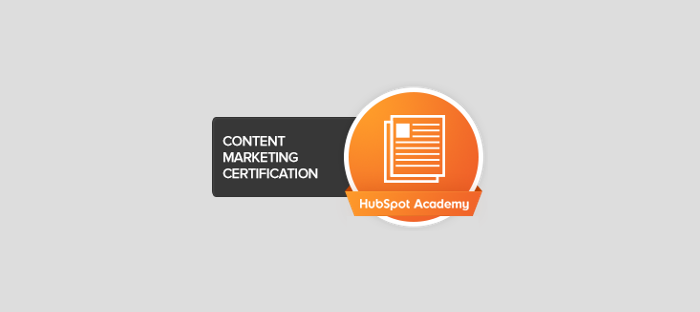Is HubSpot’s Social Media Certification Worth the Effort?

As Clariant Creative’s social media coordinator, I spend a ton of time on social media – whether it’s doing competitive research, developing a publishing strategy, creating content, designing graphics, taking pictures or monitoring our channels. But I’ll be the first to admit that I don’t know it all.
So, when HubSpot released their social media certification in July 2018, I couldn’t wait to dive in!
The certification is broken down into eight lessons and 40 videos, which adds up to about four and a half hours of video time. The lessons cover topics like social media strategy, social listening and monitoring, growing your reach with user-generated content, digital advertising and more. To earn your certification, you need to pass a timed 70-question exam.
But with all the other courses out there, is HubSpot’s social media certification worth the time and effort? And did I learn anything new that will help me grow my skills as a social media marketer? Let’s dive into some key takeaways, and at the end of this post, I’ll give you a rundown of whether this certification is worth it.
Key takeaway #1: Always start with a social media strategy
As with any other inbound marketing tactic, your first step in getting started with social media needs to be developing your social strategy. After all, posting on social media just for the sake of doing so won’t give your audience valuable content or help you achieve your goals.
To create your brand’s social media strategy, follow these steps:
- Set SMART goals and align those goals to business objectives. What are your goals for using social media? Do you want to engage with your audience, learn more about their interests, drive traffic to your website, increase leads? These are all great reasons to use social media, so take the time to figure out how social media can help your brand, and then outline those objectives by setting SMART goals.
- Consider your buyer personas. Who are your buyer personas? What social media channels do they use? What types of content are they interested in? What topics do they want to learn about? These are all questions you need to consider.
- Think about what’s worked well in the past. If you’re already using social media, conduct a content audit to see what types of content work well for your brand. Since each channel requires a different type of storytelling, your best-performing content may vary from channel to channel.
- Do competitive research. Do some competitor research to find out how your competitors use social media for their brands. Keep track of how many followers they have on each channel, how their content is performing, what types of content perform best and how their followers engage with their content. By keeping an eye on your competition, you’ll find gaps you might want to fill in your own strategy.
- Consider your resources. Not every business can afford a full-time social media marketer, so it’s important to think about what resources you have available to you. Who will write and design social content? Who will publish that content and analyze the data? If you have a smaller team (or just one person), you may want to prioritize certain channels and scale as you grow.
- Find and use the right tools. Sure, you can post directly to each channel, but the downside is many channels don’t allow you to schedule posts in advance. Investing in a social publishing tool like HubSpot, Buffer or Hootsuite will help you easily manage all your social posts for the week and save you the stress of remembering to post every day. Other tools you may want to add into the mix include:
- Social listening and monitoring tools (Google Alerts, TweetDeck, Hashtagify)
- Community management tools (Hootsuite, Sprout Social)
- Content creation tools (Canva, BeFunky, Infogram, Stencil)
- Stock photography sites (Pexels, Unsplash, Pixabay)
- Video creation tools (Vidyard, Wistia Soapbox, Loom)
- Analytics tools (Sysomos, Keyhole, Brandwatch)
Related Content: [New Data] Does Posting on Social Media via HubSpot Hurt Social Reach?
- Test, test, test. Experimentation needs to be part of your strategy, as it’s the best way to learn what resonates with your audience.
- Build a social content calendar. I’ll talk about this more in the next section, but you need to approach social content creation strategically – especially if you have limited resources. Knowing what content interests your audience and what they’re talking about online will help you decide what types of content to post.
- Be creative with your content. You shouldn’t just auto-publish your blogs and call it a day. The best part about social media is that you can have fun. So, post those memes, jokes and motivational quotes, and don’t be afraid to try something new to see how your audience responds.
Key takeaway #2: You need a social content strategy too
Putting out great content on social media is critical to your success, but too often, we forget that social content is different than other types of content you create for your business. Sure, some of the same principles apply – be human, add value, be helpful and don’t be overly self-promotional. But remember: People use social media to be informed, entertained and to stay connected, and your social content needs to cater to that.
Okay, but what does that mean?
It means letting your hair down, having fun and connecting with your audience on a truly human level. It’s about being yourself and skipping all the industry jargon. It means understanding what your social audience wants to see and giving them more of that content – even if it’s not directly tied to your brand’s product or service. It’s about listening (we’ll get to that in a minute) rather than doing all the talking. It’s about answering questions, solving problems and engaging with your followers.
Each social channel requires a different type of storytelling, and how you talk about an article on LinkedIn will be different from how you talk about it on Facebook. Additionally, not every piece of content will be ideal for every channel. Memes are great for Twitter, Facebook, Instagram and Pinterest, but they may not see the same type of response on LinkedIn. Content across each channel will vary, so consider how your audience uses different social channels and change what types of content you post accordingly.
Key takeaway #3: Social media is about listening and monitoring
Social media isn’t just about amplification; it’s about listening too. What your audience is saying about you, what types of content they want to see, what questions they have and what your competition is doing are all critical to social media success.
By definition, social listening is how you track, analyze and respond to conversations online, and it allows you to centralize conversations about your brand so you can join them. Social listening helps you:
- Manage your reputation
- Identify your biggest fans and influencers
- Identify gaps in industry offerings
- Discover new product ideas and enhancements
- Find new business opportunities
- Generate more leads
- Keep an eye on the competition
- Set strategic benchmarks for the future
Social media monitoring, on the other hand, involves actively looking for mentions and conversations that pertain to your brand, products, hashtags, employees, competitors and customers. It measures more broadly what the market is saying – not just about you, but also about your industry and the topics your audience cares about.
The biggest benefit of social monitoring is that it helps you build a stronger connection with your audience. When you monitor the social landscape, it’s no longer you and your audience talking about each other. It’s you and your audience talking about a third-party subject together. It shows that you care about your audience’s interests and humanizes the conversations you have with your audience.
When listening and monitoring, be on the lookout for damaging conversations and customer unrest. Because 87% of your customers expect a response within one hour of posting a complaint on social media, you must be on top of these conversations. And skip those auto-generated, canned replies. You need to respond to people in a way that’s authentic and helpful.
Key takeaway #4: Don’t forget to measure social media ROI
We’ve talked about measuring the ROI of your content in a few of our previous posts, but I felt it was worth mentioning again. Too often, businesses spend a ton of time posting on social media and not enough time measuring the return on investment.
Social media ROI is, by definition, the results you get from everything you do on social media, ranging from building brand awareness and loyalty, retaining and satisfying customers, protecting your reputation and directly earning revenue.
But it’s tough to measure the ROI of social media – because how can you measure goodwill or the impact of word-of-mouth marketing as a result of your social posts? Still, you need to put a system in place to regularly track ROI because it:
- Helps you understand the effectiveness of your posts
- Allows you to adjust what’s not working
- Proves the value of social media within your organization
- Shows executives the value of budgeting for your social media efforts
- Shows how social media impacts all departments beyond just marketing and sales
- Helps you understand how people are talking about your brand so you can gain control over those conversations
Create social media analytics reports at least once a month, but I’ve found it’s also helpful to create weekly analytics reports. This allows me to see our most effective content on a deeper level and really dig into what’s working and where we need to make changes.
For each channel, track metrics like:
- Best and worst performing posts
- Posts with the most engagement (comments, likes, shares)
- Number of posts per week
- Publish times of posts with the best and worst engagement
- Traffic to your website
- Video views
- Post reach and impressions
- Number of Twitter mentions
- Results of paid ad campaigns
Related Content: The Beginner’s Guide to Using Social Media for Business
Key takeaway #5: Increase reach and engagement with digital advertising
Organic reach for business pages on social media is rapidly declining, but I’m sure that doesn’t come as much of a surprise. However, that doesn’t mean you should skip out on using social media for your brand. It just means need to be creative – and invest a bit of money into social media.
I know what you’re thinking. "But the best part about using social media is that it’s free!" Maybe that was true years ago, but if your goal is to drive traffic to your website, generate more leads and increase revenue, paid advertising needs to be part of your inbound marketing strategy.
Digital advertising isn’t a waste of money by any means, and when implemented strategically, it offers your business a ton of benefits. Paid ads help you stay relevant, allow you to be present where your prospects are spending their time online and give you the opportunity to put the right content in front of the right people at a specific point in their buying journey.
When I talk about digital advertising, I’m not just talking about paid social ads. Although it’s not technically a social media channel, your digital advertising strategy should also include Google AdWords. If you’re thinking about getting started with paid ads, here are a few things to ask yourself:
- Where does our audience spend most of their time online? And how do they use these channels?
- What are our goals for digital advertising? To increase website traffic, generate more leads, improve conversion rates, drive webinar signups or e-book downloads?
- What are the right channels for paid advertising based on my audience and goals?
- What part of the buyer’s journey do we want to target? And how do we adapt our advertising strategy as prospects move through the buyer’s journey?
- How much money are we willing to invest? And how much money do we need to invest in paid advertising to reach our business goals?
Key takeaway #6: Your employees are your biggest advocates
Employee advocacy programs are a powerful source of word-of-mouth marketing and can help amplify your company’s social media presence. And since employees embody your company’s culture and values, they’re trusted three times more than CEOs.
So, why don’t more businesses have employee advocacy programs in place? Perhaps because they don’t realize how powerful employee advocacy programs can be.
Employee advocacy programs help drive employee participation while leveraging their skill set along with their industry and company knowledge to generate and distribute content to a larger audience. It increases employee engagement, amplifies your social presence, positions your employees as thought leaders in your industry, humanizes your brand, and increases brand visibility, recognition and loyalty.
While you should encourage employee participation, you can’t force people to post your brand’s content on their personal social media channels. But for employees who are interested, you can get started by:
- Educating employees on your brand’s voice and tone along with what should and shouldn’t be shared
- Providing resources and content they can share with their audience
- Giving employees the tools they need to easily create and share content (like Canva, HubSpot, Adobe Spark, etc.)
- Allowing employees to personalize graphics and content to their audience
- Acknowledging and praising employees who see results from their posts
- Offering incentives for participating like friendly competitions, free swag, prizes, paid days off and more
Don’t forget to track the success of your employee advocacy by looking at metrics like social mentions, post engagement, post clicks, website visits, conversion rates, signups or downloads and more.
Is HubSpot’s social media certification worth the effort?
Whether you’re a full-time social media marketer, you work on your company’s social media part-time or you just want to learn more about social media marketing, HubSpot’s social media certification is definitely worth the effort.
My only tiny complaint is that the certification is mostly focused on B2C social media. Many of the tactics the professors talked about and the supporting examples they provided were geared toward B2C brands.
Don’t get me wrong – you can use many of the ideas presented regardless of whether you’re a B2C or B2B brand, but there are some differences in how you’d approach these tactics depending on whether your target audience is businesses or consumers. I just wish the professors would’ve given more B2B examples or at least explained how to tailor some of the tactics to a B2B audience (since it can be a bit tricky).
Even so, I’d highly recommend this certification to any inbound marketer. The courses are full of so many tips, tricks and ideas to help you improve your company’s social media. Plus, HubSpot Academy brings in a ton of social media experts and influencers, allowing you to learn from some of the best in the industry.
I absolutely loved HubSpot’s social media certification, and I’m excited to take everything I learned and use it to make Clariant Creative’s social media even better.
Did you find this blog post helpful? We've turned this post into a terrific ebook, too! Download the PDF and you'll have everything you need to create a killer B2B social media marketing strategy.





